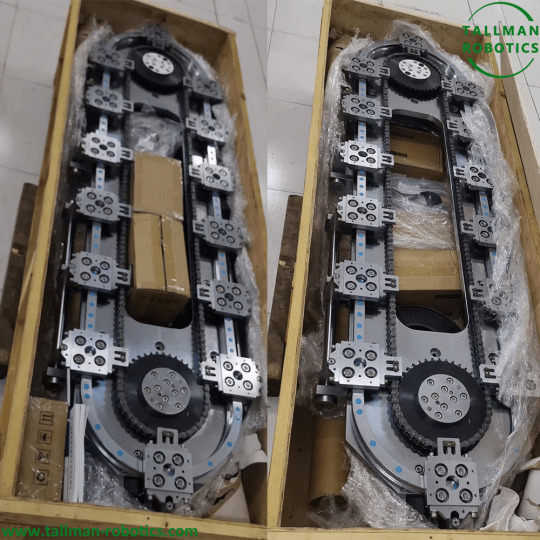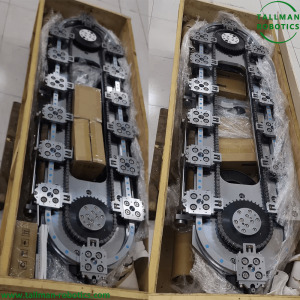#PrecisionCircularConveyorLine
Explore tagged Tumblr posts
Text
Circular Precision Track Systems Will Be Delivered To Ukraine

Circular precision track systems consist of circular tracks, precision bearings, and drive systems that enable controlled and accurate movement in circular paths.These systems typically are often used in various industries, including manufacturing, robotics, and transportation.



In manufacturing, circular precision track systems are commonly used in automated assembly lines, allowing components or products to move along precise circular paths for efficient processing. In robotics, these systems enable robotic arms or devices to move in circular motions with high precision, which is valuable in tasks such as welding, painting, or material handling. https://youtu.be/8Igb1WPw8yg In transportation, circular precision track systems can be found in applications such as amusement park rides, conveyor systems, and even some types of vehicles where circular motion is required. In recent years, Circular Precision Track Systems have gradually been recognized and widely applied in the manufacturing industry, promoting the transformation and updating of the entire industry. As a railway system technology, together with the transmission system, it can perform cyclic motion, reduce inter station flow rate, shorten production cycle, improve production efficiency, reduce personnel costs, and achieve automatic production. With market demand, professional manufacturers are constantly improving their circular guide rail technology and developing more suitable industries. So what kind of device is a circular guide rail(Circular Precision Track Systems)? Circular Precision Track Systems can perform open or closed movements, and each slider is suitable for multiple production lines of pipelines. As an assembly line, it meets the requirements of precision assembly. The workpiece usually needs to be installed in precision accessories. During assembly, the circular guide rail sliding piece can be placed with attachments to perform the cyclic movement of the device, thereby automating the assembly line. The application of system technology circular guide rail can reduce personnel costs, Improve production efficiency. Based on the research on ultra-high load low-frequency cooling technology Circular Precision Track Systems, and based on the structural characteristics and technical requirements of the parts, technical difficulties were analyzed, and a series of process technology parameters and assumptions were proposed. According to relevant tests, the parameters are ultra-high diameter, ultra-high load low-frequency rapid cooling process for Circular Precision Track Systems, and flat grinding device circular guide rails belong to the field of assembly and manufacturing technology. Currently, new types include support plates and grinding mechanisms, And a mobile mechanism installed on the support plate. By rotating the transmission device through a gear transmission device, the gear connected to the transmission shaft in a fixed manner is located outside the ring gear component, meshing and rotating. Through the rotation of the grinding wheel and the grinding device, the surface ring guide rail of the ring gear is uniformly rectified to compensate for the shortcomings of the processing equipment. With the existing large-scale, surface large diameter rings are inexpensive, zero transportation, and efficient, Perform polishing treatment and achieve high polishing accuracy. The above content is an introduction to what kind of device Circular Guide Rail Sytems are. Nowadays, the transmission method of Circular Guide Rail Sytems includes multiple working platforms, main bearings, and multiple rotatably connected to the main support wheels, as well as multiple platforms with multiple rotating wheels. The circular guide rail is sequentially connected to the transmission belt along the circumferential direction of the transmission belt. The transmission method is to set a linear guide rail between two adjacent rotating wheels in the main bracket, Each work platform is equipped with sliders, track linear guides, and sliders, which are designed to make the work level with each other. You are welcome to https://www.youtube.com/@tallmanrobotics to watch our video centre for more projects or visit our website to check other series or load down e-catalogues for further technical data. Read the full article
#CircularGuideRailSytem#PrecisionCircularConveyorLine#PrecisionTrackSystems#RingGuidesandTrackSystems
0 notes
Text
Chain Link Circular Conveyor Is Packed Well For Delivery to Germany

A chain link circular conveyor is a type of conveyor system that utilizes a continuous loop of interlocking metal or plastic chain links to transport items in a circular path. It is commonly used in various industries, including manufacturing, packaging, and material handling.

Chain link circular conveyors find various applications in the manufacturing industry due to their ability to efficiently transport items in a continuous loop. Some common applications of chain link circular conveyors in the manufacturing industry include: 1. Assembly Lines: Chain link circular conveyors are often used in assembly lines to transport components or products between different workstations. They can move items through various stages of assembly, allowing workers to perform specific tasks at each station. 2. Packaging: Circular conveyors are frequently employed in packaging lines to transport products to different packaging stations. They can carry items to be wrapped, boxed, labeled, or sealed, ensuring a smooth and efficient packaging process. 3. Material Handling: Chain link circular conveyors are used for the movement of raw materials, intermediate products, or finished goods within a manufacturing facility. They can transport items between different production areas, storage locations, or loading docks. 4. Inspection and Testing: conveyors can be incorporated into inspection and testing processes. Items can be transported along the conveyor for quality control checks, measurements, or testing procedures. This allows for systematic and consistent assessment of products during manufacturing. 5. Heat Treatment and Drying: In processes that involve heat treatment or drying, conveyors can be utilized to move items through ovens, kilns, or drying chambers. The continuous loop ensures even exposure to heat or drying conditions, promoting uniform treatment or drying of products. 6. Sorting and Accumulation: conveyors can be equipped with sorting mechanisms, such as diverters or pushers, to sort items based on specific criteria such as size, shape, or destination. They can also be used for accumulation, temporarily storing items until they are ready for further processing or packaging. 7. Food Processing: In the food industry, circular conveyors are employed for various processes like washing, blanching, cooling, or freezing of food products. They can transport items through different stages of food processing, maintaining hygiene and efficiency. 8. Automotive Manufacturing: conveyors are widely used in automotive manufacturing plants for tasks such as conveying car parts, moving vehicles between assembly stations, or transporting components to paint booths. These are just a few examples of how conveyors are utilized in the manufacturing industry. Their versatility, space efficiency, and continuous operation make them suitable for a wide range of applications, improving production efficiency and streamlining material handling processes. You are welcome to https://www.youtube.com/@tallmanrobotics to watch our video centre for more projects or visit our website to check other series or load down e-catalogues for further technical data. Read the full article
#Chainconveyor#ChainConveyorRoundLinkChain#Circularchainconveyor#Linkconveyorchain#PrecisionCircularConveyorLine#RoundLinkChainConveyor#RoundLinkChainforConveyors#RoundLinkSteelChains
0 notes